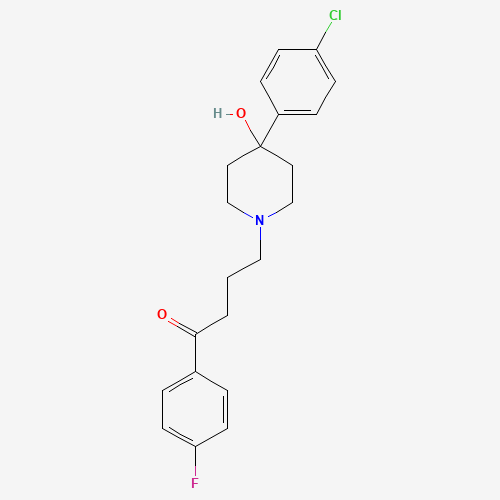| Pharmaceutical Information |
| Drug Name |
Haloperidol |
| Drug ID |
BADD_D01054 |
| Description |
Haloperidol is a high potency first-generation (typical) antipsychotic and one of the most frequently used antipsychotic medications used worldwide.[A180616] While haloperidol has demonstrated pharmacologic activity at a number of receptors in the brain,[A27477] it exerts its antipsychotic effect through its strong antagonism of the dopamine receptor (mainly D2), particularly within the mesolimbic and mesocortical systems of the brain. Haloperidol is indicated for the treatment of the manifestations of several psychotic disorders including schizophrenia, acute psychosis, Tourette syndrome, and other severe behavioural states.[F4645] It is also used off-label for the management of chorea associated with Huntington's disease and for the treatment of intractable hiccups as it is a potent antiemetic. Dopamine-antagonizing medications such as haloperidol are though to improve psychotic symptoms and states that are caused by an over-production of dopamine, such as schizophrenia, which is theorized to be caused by a hyperdopaminergic state within the limbic system of the brain.[A34360]
Use of the first-generation antipsychotics (including haloperidol) is considered highly effective for the management of the "positive" symptoms of schizophrenia including hallucinations, hearing voices, aggression/hostility, disorganized speech, and psychomotor agitation. However, this class of drugs is also limited by the development of movement disorders induced by dopamine-blockade such as drug-induced parkinsonism, akathisia, dystonia, tardive dyskinesia, as well as other side effects including sedation, weight gain, and prolactin changes. While there are limited high-quality studies comparing haloperidol to lower-potency first-generation antipsychotics such as [DB00477], [DB01624], [DB00623], and [DB01403], haloperidol typically demonstrates the least amount of side effects within this class, but demonstrates a stronger disposition for causing extrapyramidal symptoms (EPS).[A180613, A180616, A180625] These other low‐potency antipsychotics are limited by their lower affinity for dopamine receptors, which requires a higher dose to effectively treat symptoms of schizophrenia. In addition, they block many receptors other than the primary target (dopamine receptors), such as cholinergic or histaminergic receptors, resulting in a higher incidence of side effects such as sedation, weight gain, and hypotension.
Interestingly, in vivo pharmacogenetic studies have demonstrated that the metabolism of haloperidol may be modulated by genetically determined polymorphic _CYP2D6_ activity. However, these findings contradict the findings from studies in vitro with human liver microsomes and from drug interaction studies in vivo. Inter-ethnic and pharmacogenetic differences in haloperidol metabolism may possibly explain these observations.[A32346]
First-generation antipsychotic drugs have largely been replaced with second- and third-generation (atypical) antipsychotics such as [DB00734], [DB00334], [DB00363], [DB01224], [DB01238], and [DB00246]. However, haloperidol use remains widespread and is considered the benchmark for comparison in trials of the newer generation antipsychotics.[A180625]
The efficacy of haloperidol was first established in controlled trials in the 1960s.[A180610] |
| Indications and Usage |
Haloperidol is indicated for a number of conditions including for the treatment of schizophrenia, for the manifestations of psychotic disorders, for the control of tics and vocal utterances of Tourette’s Disorder in children and adults, for treatment of severe behavior problems in children of combative, explosive hyperexcitability (which cannot be accounted for by immediate provocation). Haloperidol is also indicated in the short-term treatment of hyperactive children who show excessive motor activity with accompanying conduct disorders consisting of some or all of the following symptoms: impulsivity, difficulty sustaining attention, aggressivity, mood lability, and poor frustration tolerance. Haloperidol should be reserved for these two groups of children only after failure to respond to psychotherapy or medications other than antipsychotics.[F4645] |
| Marketing Status |
approved |
| ATC Code |
N05AD01 |
| DrugBank ID |
DB00502
|
| KEGG ID |
D00136
|
| MeSH ID |
D006220
|
| PubChem ID |
3559
|
| TTD Drug ID |
D0D1AL
|
| NDC Product Code |
0904-7389; 10135-754; 50090-4365; 51079-431; 51079-733; 67296-1462; 68084-249; 68382-081; 71247-155; 72205-064; 0904-6733; 0904-7240; 0904-7242; 51079-734; 55154-3566; 63629-9270; 0378-0335; 0404-9871; 70518-2620; 70518-2687; 70518-3668; 72205-066; 17337-0518; 0904-7390; 10135-753; 50090-6017; 63629-9273; 63629-9275; 65841-838; 68084-250; 68382-407; 69292-588; 70518-2893; 70518-3587; 71247-154; 54838-501; 60687-161; 63629-9271; 0378-0327; 65841-626; 68382-080; 70518-0831; 70518-1269; 70518-3021; 71247-151; 0832-1510; 51079-735; 55154-5059; 58657-703; 63629-9274; 65841-837; 69292-582; 70518-1599; 70518-3440; 71247-153; 0832-1560; 0904-6782; 0904-7241; 51927-0203; 76420-293; 35573-442; 58657-701; 58657-702; 63629-2326; 0378-0257; 70518-2682; 70518-3608; 71247-150; 72205-068; 72205-069; 38779-0330; 0904-7391; 10135-755; 66412-0506; 67763-121; 69766-069; 58657-705; 63187-842; 63629-9272; 68382-409; 70518-2680; 70518-3500; 0615-8355; 0832-1520; 0904-6661; 10135-752; 62991-2031; 35573-441; 51079-736; 68083-117; 68382-079; 69292-580; 69292-584; 69292-586; 69292-590; 72205-067; 0904-7112; 48292-0007; 51552-0519; 50090-5989; 0378-0334; 0378-0351; 68382-408; 71247-152; 12578-617; 35573-440; 58657-704; 0378-0214; 65841-627; 65841-628; 65841-839; 70518-1182; 70518-3437; 72205-065; 0832-1530; 0832-1540; 0832-1550; 46014-1114; 49452-3446; 10135-756; 10135-757; 0121-0581; 58657-700 |
| UNII |
J6292F8L3D
|
| Synonyms |
Haloperidol | Haldol |
|
| Chemical Information |
| Molecular Formula |
C21H23ClFNO2 |
| CAS Registry Number |
52-86-8 |
| SMILES |
C1CN(CCC1(C2=CC=C(C=C2)Cl)O)CCCC(=O)C3=CC=C(C=C3)F |
| Chemical Structure |

|
|
| ADRs Induced by Drug |
|
|
*The priority for ADR severity classification is based on FAERS assessment, followed by the most severe level in CTCAE rating. If neither is available, it will be displayed as 'Not available'.
**The 'Not Available' level is hidden by default and can be restored by clicking on the legend twice..
|
|
|

